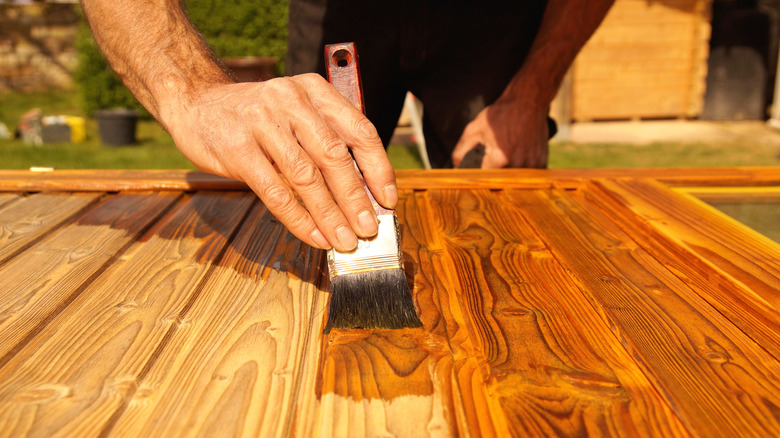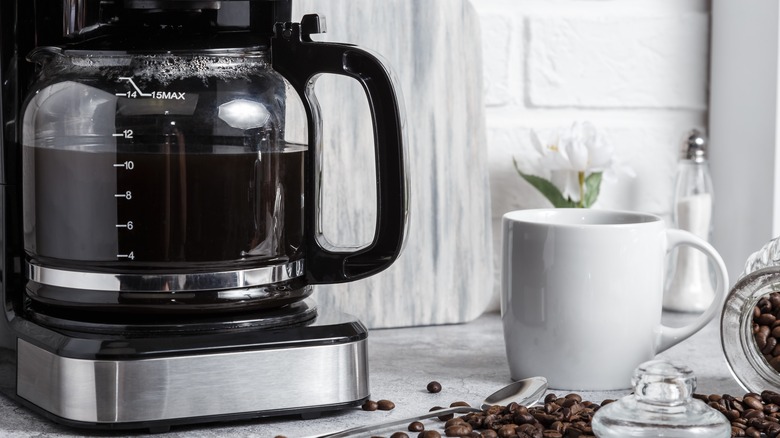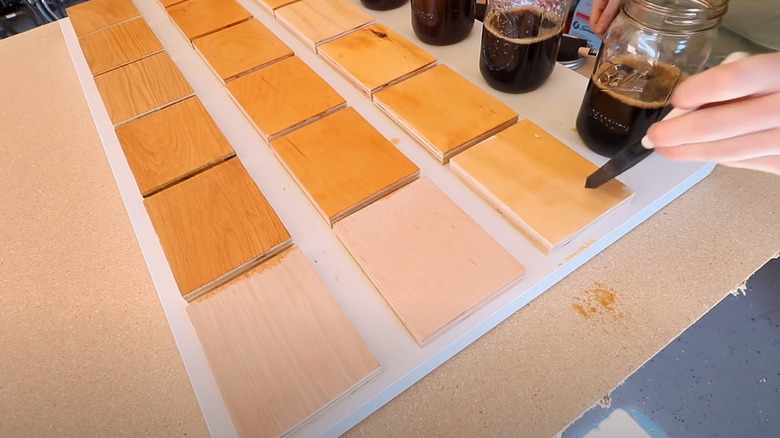The Ingredient You Can Use To Naturally Stain Wood
We may receive a commission on purchases made from links.
When it comes to breathing life into an age-worn piece of wood furniture, think of staining as the proverbial "rising from the ashes." Staining wood transcends the superficial; it fosters durability and remarkable wood grain patterns, giving your furniture an appealing, long-lasting finish. But before you dash off to the local home improvement store for a can of traditional wood stain, take a detour to your kitchen, and you'll find your unlikely hero — coffee. Yes, your daily caffeine companion, highly appreciated for extinguishing morning grogginess and catalyzing high-octane days, can enhance your furniture's charm in the most straightforward, homely way.
Coffee's staining secret lies in its abundance of tannins. These water-soluble polyphenols, also present in tea, react with the cellulose in wood, darkening its surface. Talk of the perfect blend of artistry and science. The advantages of staining wood with coffee are manifold. Coffee wood stain's organic nature implies it's free from harsh chemicals (thus, health-friendly, with its non-flammability and easy application further elevating its appeal. The cost? Virtually the price of a few cups of your daily brew. And time? This is mainly determined by the size of the item and the darkness of the shade you aim for. It can take as little as 15 minutes for one layer to an excess of four hours for two or more coats.
How do you coffee-stain wood?
Staining wood with coffee begins with gathering the required supplies. That will include dark roast coffee, a brewer, sandpaper (grits 80, 120, and 220), a sponge or lint-free cloth, a paintbrush, and a water-based sealant. Now, onto your homemade wood stain recipe. It's as simple as brewing a pot of strong coffee. Using darker roast coffee and steeping your brew longer ensures a rich hue.
As the brew cools, channel your focus into wood preparation. Take your sandpaper, starting with the coarsest grit at 80, to scrape away any existing finishes. Gradually polish your wood using finer sandpaper, progressing from 120-grit to 220-grit. The end goal? Smooth wood with open grains that will eagerly soak up your homemade wood stain. Follow up with a thorough wipe-down using a sponge to rid any traces of residual dust or particles.
Into the grand finale now, one that rivals your morning espresso ritual. Soak your sponge, cloth, or foam brush in the brewed coffee, then apply the stain in the wood grain's direction, caressing each ridge, and carve carefully. Let Mother Nature take command next; leave your canvas undisturbed to dry thoroughly. Fancy a deeper shade? Then, add extra layers of coffee stain, allowing each to dry for about two hours before slathering in the next. Once satisfied with the richness of your masterpiece, seal it with a water-based sealant like Simple Finish from Maker Brand and watch the hues come to life, protected and radiant.
Caveats for staining wood with coffee
Using an orbital sander instead of manual sanding when working on a sizeable wooden piece will save you time and elbow grease. As a seasoned DIYer or woodworker will tell you, different woods absorb and react to stains uniquely. This makes it crucial to test the coffee stain on a less noticeable area or a scrap piece of wood before you go all in. If your piece is greasy, washing it with dish soap and water before sanding might be worthwhile. Other options for degreasing wood are lemon juice, rubbing alcohol, and baking soda-water solution.
Beware that sealants can kick up quite a stink (literally), so ensure proper ventilation in your workspace. Applying a wood conditioner before staining a soft wood piece ensures uniformity. As coffee is water-based, pick a water-based wood conditioner like Minwax 618514444 Water-Based Pre-Stain Wood Conditioner on Amazon. It boasts a 4.5/5 score from 400+ ratings.
And if the coffee stain raises the wood grain against your wish? Simply give it a light sanding after the stain coat dries. If craving a more rustic look, apply wet coffee grounds directly to the wood's surface. After letting them sit for a few minutes, wipe away the grounds to reveal a unique, textured appearance. And when your adventurous mood kicks in, or coffee isn't your cup of tea (pun intended)? Don't be afraid to experiment with other organic staining materials like black tea, beetroot juice, or walnut hulls to stain wood furniture naturally.


